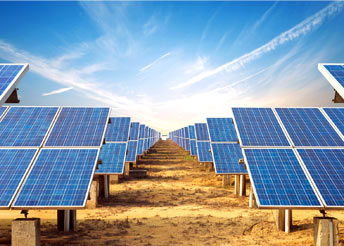
Solar Power in India
Solar energy is supposed to be a potent and charismatic source of energy. India is both densely populated and has high solar Insolation, providing an ideal combination for Solar Power in India. India lies within one of the sunniest regions around the world. Most parts of India receive 4-7 kWh of solar radiation per square meter per day with 300-325 sunny days in a year. India has abundance of solar resources, as it receives about 3000 hours of sunshine every year, equivalent to over 5,000 trillion kWh.
Solar power in India is a fast-growing industry and as of 31 December 2016, the country's solar grid had a cumulative capacity of 9,012.66 Megawatts (MW) or 9.01 Gigawatts (GW). In January 2015, the Indian government expanded its solar plans, targeting US $ 100 billion of investment and 100 GW of solar capacity, including 40 GW's directly from rooftop solar, by 2022. The rapid growth in deployment of solar power is recorded and updated monthly on the Indian Government's Ministry of New and Renewable Energy website. Large scale solar power deployment began only as recently as 2010, yet the ambitious targets would see India installing more than double that achieved by world leaders China or Germany in all of the period up to 2015 year end.
In the year 2009, Jawaharlal Nehru National Solar Mission was launched, having an initial target of 20 GW of solar power capacity by the year 2022. However, the same has been revised under the auspices of current government to 100 GW by the year 2022. Furthermore, India has recently taken a step forward initiative to launch International Solar Alliance (ISA) – an umbrella organisation of 121 countries lying between Tropic of Cancer & Tropic of Capricorn, which is headquartered at National Institute of Solar Energy, Gurgaon. The Government of India has provided USD 30 million as a seed fund to start with day to day operations. The aim of ISA is to facilitate technology transfer, make various available means of financing to developing countries and make Solar Energy a mantra for sustainable development.
Targets of (NSM) Phase-II, Application Segment Target for Phase 2 (2013-17)
Grid solar power (large plants, roof top & distribution grid plants) 9,000 MW Off-grid solar applications 800 MW
Solar Thermal Collectors (SWHS, solar cooking, solar cooling, Industrial process heat applications, etc.) 8 million sq. meters
Future Plan
Vision for 100,000 MW of solar power capacity by 2022 is proposed as below:
(Capacity in MW) Category-I, Proposed Capacity Category-II, Proposed Capacity Rooftop Solar 40,000 Projects by Unemployed graduates, Village Panchayats, Small Scale Industries (SSI) Units 10,000
Public Sector Undertakings 10,000 Large Private Sector 5,000 SECI 5,000 Under State Policies 20,000 Ongoing programs 10,000* Total 40,000 60,000* * 3743 MW commissioned up-to 2014-15
Focus area under Phase-II of NSM
A) Grid connected Projects
Unlike Phase-I, NSM Phase-II aim for achieving significantly higher scales of targets of 100 GW. Hence, Ministry has contemplated all possible options for implementation of the mission. Selection
of capacity for Phase-II, grid connected projects is being done via different schemes such as Bundling, Viability Gap Funding (VGF). This allocation of target capacity may be altered depending upon the availability of resources.
Moreover, large scale solar power deployment began by 2010. Initially central government came out as a tender after which several states followed the suit and framed their own Solar Policies to deal with, their own solar power projects, which had an impact of lowering levelized solar tariff. This was further getting necessitated because of mandatory RE (Renewable Energy) targets given by MNRE to each and every state which asked for a Renewable Purchase Obligation i.e. to purchase a percentage of power from renewable sources based on area and geographical location.






